能够修饰形容词、副词的比较级和最高级的词或短语
- 格式:doc
- 大小:24.50 KB
- 文档页数:1
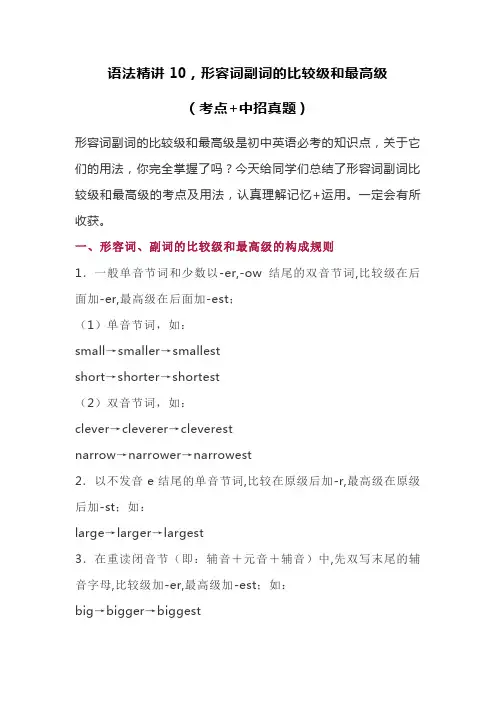
语法精讲10,形容词副词的比较级和最高级(考点+中招真题)形容词副词的比较级和最高级是初中英语必考的知识点,关于它们的用法,你完全掌握了吗?今天给同学们总结了形容词副词比较级和最高级的考点及用法,认真理解记忆+运用。
一定会有所收获。
一、形容词、副词的比较级和最高级的构成规则1.一般单音节词和少数以-er,-ow结尾的双音节词,比较级在后面加-er,最高级在后面加-est;(1)单音节词,如:small→smaller→smallestshort→shorter→shortest(2)双音节词,如:clever→cleverer→cleverestnarrow→narrower→narrowest2.以不发音e结尾的单音节词,比较在原级后加-r,最高级在原级后加-st;如:large→larger→largest3.在重读闭音节(即:辅音+元音+辅音)中,先双写末尾的辅音字母,比较级加-er,最高级加-est;如:big→bigger→biggesthot→hotter→hottestfat→fatter→fattest4.以“辅音字母+y”结尾的双音节词, 把y改为i,比较级加-er,最高级加-est;如:easy→easier→easiestheavy→heavier→heaviest5.其他双音节词和多音节词,比较级在前面加more,最高级在前面加most;如:beautiful→more beautiful→most beautifuldifferent→more different→most differenteasily→more easily→most easily注意:(1)形容词最高级前通常必须用定冠词 the,副词最高级前可不用.The Sahara is the biggest desert in the world.(2)形容词most前面没有the,不表示最高级的含义,只表示"非常".It is a most important problem.=It is a very important problem.6.有少数形容词、副词的比较级和最高级是不规则的,必须熟记。
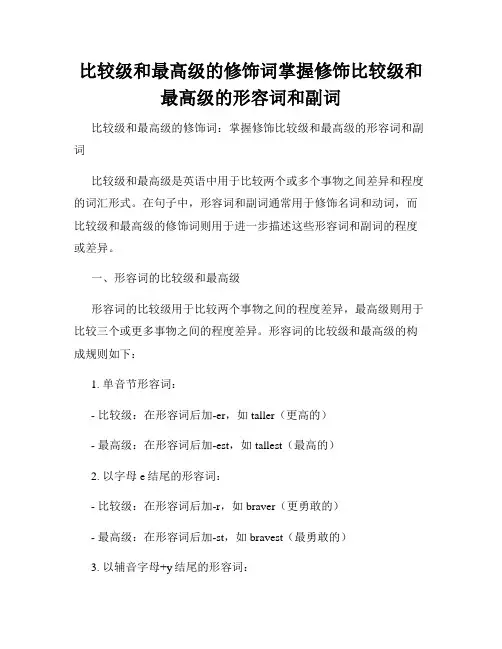
比较级和最高级的修饰词掌握修饰比较级和最高级的形容词和副词比较级和最高级的修饰词:掌握修饰比较级和最高级的形容词和副词比较级和最高级是英语中用于比较两个或多个事物之间差异和程度的词汇形式。
在句子中,形容词和副词通常用于修饰名词和动词,而比较级和最高级的修饰词则用于进一步描述这些形容词和副词的程度或差异。
一、形容词的比较级和最高级形容词的比较级用于比较两个事物之间的程度差异,最高级则用于比较三个或更多事物之间的程度差异。
形容词的比较级和最高级的构成规则如下:1. 单音节形容词:- 比较级:在形容词后加-er,如taller(更高的)- 最高级:在形容词后加-est,如tallest(最高的)2. 以字母e结尾的形容词:- 比较级:在形容词后加-r,如braver(更勇敢的)- 最高级:在形容词后加-st,如bravest(最勇敢的)3. 以辅音字母+y结尾的形容词:- 比较级:将“y”改为“i”,加-er,如busier(更忙的)- 最高级:将“y”改为“i”,加-est,如busiest(最忙的)4. 多音节形容词和部分双音节形容词:- 比较级:在形容词前加more(更...的),如more beautiful(更美丽的)- 最高级:在形容词前加most(最...的),如most beautiful(最美丽的)值得注意的是,有一些形容词的比较级和最高级形式是不规则变化的,需要特殊记忆,比如good(好)的比较级为better(更好的),最高级为best(最好的)。
二、副词的比较级和最高级副词的比较级和最高级的构成方式与形容词类似,不同的是它们要在副词前加上more或most。
比较级用于比较两个动作或状态之间的程度差异,最高级则用于比较三个或更多动作或状态之间的程度差异。
比较级和最高级的构成规则如下:1. 单音节副词和部分双音节副词:- 比较级:在副词前加更(更...地),如faster(更快地)- 最高级:在副词前加most(最...地),如fastest(最快地)2. 多音节副词和以-ly结尾的副词:- 比较级:在副词前加more(更...地),如carefully(更小心地)- 最高级:在副词前加most(最...地),如most carefully(最小心地)需要注意的是,有一些副词的比较级和最高级形式也是不规则变化的,比如well(好)的比较级为better(更好地),最高级为best(最好地)。
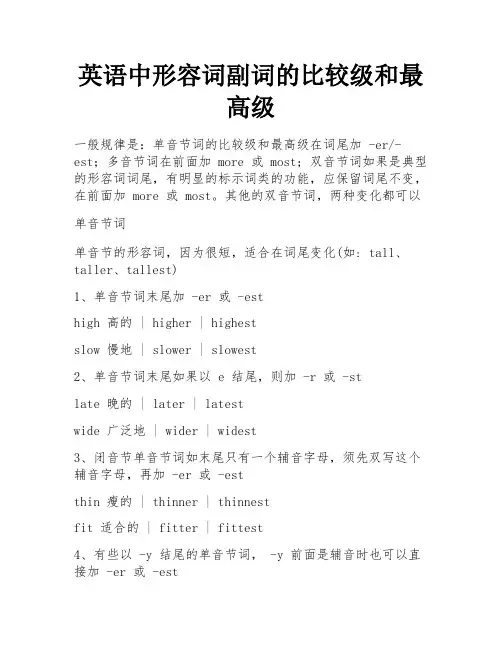
英语中形容词副词的比较级和最高级一般规律是:单音节词的比较级和最高级在词尾加 -er/-est;多音节词在前面加 more 或 most;双音节词如果是典型的形容词词尾,有明显的标示词类的功能,应保留词尾不变,在前面加 more 或 most。
其他的双音节词,两种变化都可以单音节词单音节的形容词,因为很短,适合在词尾变化(如: tall、taller、tallest)1、单音节词末尾加 -er 或 -esthigh 高的 | higher | highestslow 慢地 | slower | slowest2、单音节词末尾如果以 e 结尾,则加 -r 或 -stlate 晚的 | later | latestwide 广泛地 | wider | widest3、闭音节单音节词如末尾只有一个辅音字母,须先双写这个辅音字母,再加 -er 或 -estthin 瘦的 | thinner | thinnestfit 适合的 | fitter | fittest4、有些以 -y 结尾的单音节词, -y 前面是辅音时也可以直接加 -er 或 -estshy 害羞的 | shyer | shyestsly 狡猾的 | slyer | slyestwry 讽刺的 | wryer | wryest多音节词三个音节以上的多音节词已经很长,不适合再加词尾变化,因而在前面加 more 或 most,表示更(最)...,或者加 less 或least ,表示更(最)不...interesting 有趣的 | more interesting | most interestingimportant 重要的 | less important | least importantcarefully 认真地 | more carefully | most carefully双音节词双音节形容词很尴尬:不长不短,怎么判断?1、词尾是典型的形容词词尾,有明显的标示词类的功能,应保留词尾不变,在前面加 more 或 mostcrowded more crowded most crowdedloving more loving most lovinghelpful more helpful most helpfulfamous more famous most famousactive more active most active2、其他的双音节形容词,如果不是典型的形容词字尾,变化则无限制,两种变化都可以often oftener(more often) oftenest(most often)shallow shallower(more shallow) shallowest(most shallow)3、如果是 -y 结尾,这个长母音因为发音上的要求,要先变成短母音的 i,再加字尾变化,如:happy happier happiestlucky luckier luckiest二、不规则形式good/well | better | bestbad/ill/badly | worse | worstmany/much | more | mostlittle | less | leastfar | farther/further | farthest/furthestold | older/elder | oldest/eldest三、比较等级英语中形容词副词有三个比较等级,即原级、比较级和最高级1、原级(1) 表示程度相同,即“和...一样...”时用原级,常用"as... as" 结构It is as beautiful as paradise in Heaven. 这里如天堂般美丽This room is as broad as it is long. 那个房间长宽相等He is as handsome as John (is). 他和约翰一样英俊He studies as hard as John (does). 他和约翰一样努力(2) as...as... 引导的结构可采用倒装句型He studies as hard as John (does). = He studies as hard as does John.He is as handsome as John is. = He is as handsome as is John.(3) 否定的原级用 not as...as 或not so...as,二者区别不大You are not as tall as he. 你没有他高Guangzhou is not as clean as Shanghai. 广州没有上海那么干净I didn't do so well as I should. 我做得不如我应做得那么好(4) as/so... as... 结构前可以用 just、quite、almost、nearly、half 等词在程度上加以修饰This story was quite as interesting as we had thought. 这个故事和我们想的一样精彩The bike is not half so new as mine. 这辆自行车还没我的一半新She can read twice as fast as he does. 她的阅读速度比他快一倍John is not quite as good a student as his sister.连接词 as 表示这是组 as..as 的比较级。
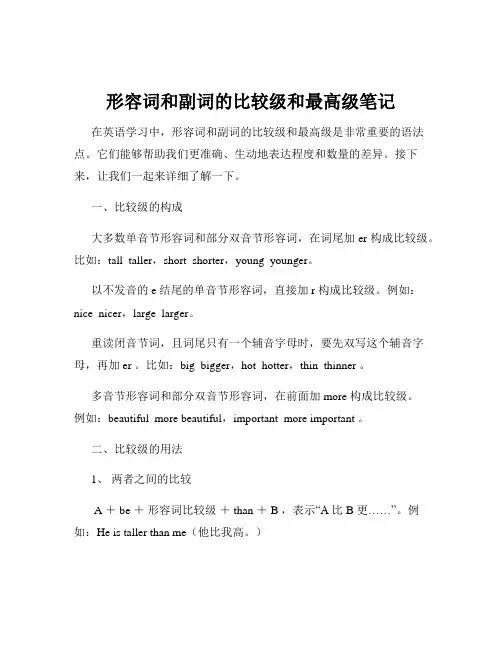
形容词和副词的比较级和最高级笔记在英语学习中,形容词和副词的比较级和最高级是非常重要的语法点。
它们能够帮助我们更准确、生动地表达程度和数量的差异。
接下来,让我们一起来详细了解一下。
一、比较级的构成大多数单音节形容词和部分双音节形容词,在词尾加 er 构成比较级。
比如:tall taller,short shorter,young younger。
以不发音的 e 结尾的单音节形容词,直接加 r 构成比较级。
例如:nice nicer,large larger。
重读闭音节词,且词尾只有一个辅音字母时,要先双写这个辅音字母,再加 er 。
比如:big bigger,hot hotter,thin thinner 。
多音节形容词和部分双音节形容词,在前面加 more 构成比较级。
例如:beautiful more beautiful,important more important 。
二、比较级的用法1、两者之间的比较A + be +形容词比较级+ than +B ,表示“A 比 B 更……”。
例如:He is taller than me(他比我高。
)A +实义动词+副词比较级+ than +B ,表示“A 做某事比 B 更……”。
例如:She runs faster than him(她跑得比他快。
)2、比较级+ and +比较级,表示“越来越……”。
例如:It's getting colder and colder(天气变得越来越冷。
)3、The +比较级,the +比较级,表示“越……,越……”。
例如:The more you read, the more knowledge you will get(你读得越多,你获得的知识就越多。
)4、可以用 much、a little、a lot、even、far 等修饰比较级,加强比较的程度。
例如:He is much taller than me(他比我高得多。
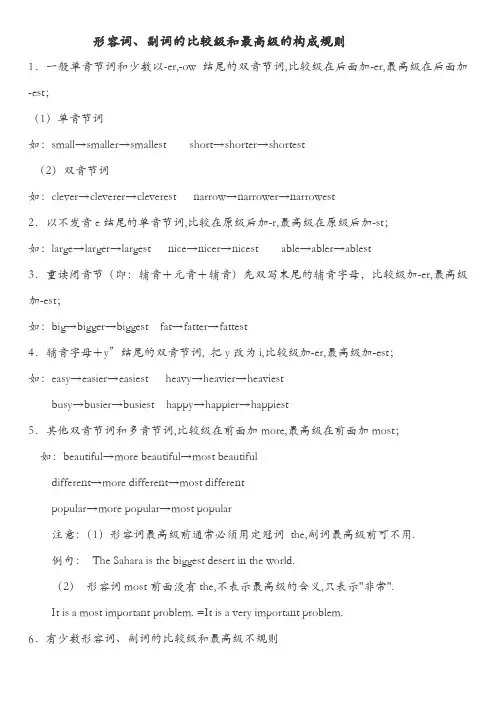
形容词、副词的比较级和最高级的构成规则1.一般单音节词和少数以-er,-ow结尾的双音节词,比较级在后面加-er,最高级在后面加-est;(1)单音节词如:small→smaller→smallest short→shorter→shortest(2)双音节词如:clever→cleverer→cleverest narrow→narrower→narrowest2.以不发音e结尾的单音节词,比较在原级后加-r,最高级在原级后加-st;如:large→larger→largest nice→nicer→nicest able→abler→ablest3.重读闭音节(即:辅音+元音+辅音)先双写末尾的辅音字母,比较级加-er,最高级加-est;如:big→bigger→biggest fat→fatter→fattest4.辅音字母+y”结尾的双音节词, 把y改为i,比较级加-er,最高级加-est;如:easy→easier→easiest heavy→heavier→heaviestbusy→busier→busiest happy→happier→happiest5.其他双音节词和多音节词,比较级在前面加more,最高级在前面加most;如:beautiful→more beautiful→most beautifuldifferent→more different→most differentpopular→more popular→most popular注意:(1)形容词最高级前通常必须用定冠词the,副词最高级前可不用.例句:The Sahara is the biggest desert in the world.(2)形容词most前面没有the,不表示最高级的含义,只表示"非常".It is a most important problem. =It is a very important problem.6.有少数形容词、副词的比较级和最高级不规则good→better→best well→better→best bad→worse→worst ill→worse→worst old→older/elder→oldest/eldestmany/much→more→most little→less→least形容词、副词的比较级和最高级的用法1.“A + be +形容词比较级+ than + B”意思为“A比B更……”.如:This tree is taller than that one. 这棵树比那棵树高.①在含有连词than的比较级中,前后的比较对象必须是同一范畴,即同类事物之间的比较.②在比较级前面使用much,表示程度程度“强得多”.如:A watermelon is much bigger than an apple.③very, quite一般只能修饰原级,不能修饰比较级.2.“比较级+ and + 比较级”或“more and more +原级”表示“越来越……”如:It becomes warmer and warmer when spring comes.春天来了,天气变得越来越暖和了.The wind became more and more heavily. 风变得越来越大.3.含有or的选择疑问句中,如果有两者供选择,前面的形容词要用比较级形式.如:Who is taller,Tim or Tom? 谁更高,Tim还是Tom?4. “the +比较级……, the+比较级”,表示“越……越……”.The sooner,the better. 越快越好.5. 表示倍数的比较级用法:①. A is …times the size /height/length/width of B. 如:The new building is three times the height of the old one.这座新楼比那座旧楼高三倍.(新楼是旧楼的四倍高)②. A is …times as big /high/long/wide/large as B.如:Asia is four times as large as Europe.亚洲是欧洲的四倍大.(亚洲比欧洲大三倍)③. A is …times larger /higher/longer/wider than B.如:Our school is twice bigger than yours.我们学校比你们学校大两倍.6.形容词、副词的最高级形式主要用来表示三者或三者以上人或事物的比较,表示“最……”的意思.如:He is the tallest in our class. 他在我们班里是最高的.7."否定词语+比较级","否定词语+ so…as"结构表示最高级含义. Nothing is so easy as this. =Nothing is easier than this. =This is the easiest thing.8. 比较级与最高级的转换: Mike is the most intelligent in his class. Mike is more intelligent than any other student in his class9.修饰比较级和最高级的词(1)可修饰比较级的词①.a bit, a little, rather, much, far, by far, many, a lot, lots, a great deal, any, still, even等. (除by far外,必须置于比较级形容词或副词的前面. )②. 可用表倍数的词或度量名词作修饰语.(2)下列词可修饰最高级:by far, far, much, mostly, almost. This hat is nearly / almost the biggest.10. 序数词通常只修饰最高级. 11.要避免重复使用比较级. 12.要避免将主语含在比较对象中. 13.要注意冠词的使用,后有名词的时候,前面才有可能有名词.形容词,副词的比较级和最高级一:比较级,最高级的构成1 在单音节形容词和部分以-er , -ow , -ble , -ple 结尾的双音节词后面直接+er;+est例:warm → warmer → warmest hi gh → higher →highestslow → slower → slowest able → abler → ablestsimple → simpler → simplest2 形容词,副词以e结尾时→+r;+st例:nice → nicer → nicestlarge → larger → largest3 形容词,副词以辅音+y结尾时→变y为i+er;+est例:busy → busier → busiest happy → happier → happiest**** shy → shier → shiest / shyer → shyestsly → slier → sliest / slyer → slyest4 以一个辅音字母结尾的重读闭音节的形容词或副词→双写词尾字母再+er;+est例:hot → hotter → hottest big → bigger → biggest5 多音节词(3个或3个以上音节)和部分双音节的词在前面加→ more~;most~例:beautiful → more beautiful → most beautifuluseful → more useful → most usefulfamous → more famous → most famous6 不规则变化:7 特殊情况:⑴下列各词无比较级和最高级:wrong right correct true empty perfect excellent unique extreme extremely readypossible possibly chief main mainly final sufficient fatal primary absolute absolutely entire entirely infinite naked favorite⑵下列单音节词变比较级和最高级时在前面加more~;most~累的:tired → more tired → most tired高兴的:glad → more glad → most glad无聊的:bored → more bored → most bored喜欢的:fond → more fond → most fond高兴的,愉快的:pleased → more pleased → most pleased用旧的,用坏的:worn → more worn → most worn真的,真实的:real → more real → most real热衷的,喜爱的,着迷的:keen → more keen → most keen⑶下列词即可以直接+er;+est,又可以more~;most~聪明的clever → cleverer → cleverest / more clever → most clever经常often → oftener → oftenest / more often → most often残酷的cruel → crueler → cruelest / more cruel → most cruel严厉的strict → stricter → strictest / more strict → most strict狭窄的,狭隘的narrow → narrower → narrowest / more narrow → most narrow淘气的naughty → naughtier → naughtiest / more naughty → most naughty困的,想睡觉的sleepy → sleepier → sleepiest / more sleepy → most sleepy友好的friendly → friendlier → friendliest/ more friendly → most friendly充满活力的,活泼的lively → livelier → liveliest/ more lively → most lively安全的,可靠的secure → securer → securest / more secure → most secure浅的,肤浅的,无关紧要的shallow → shallower → shallowest / more shallow → most shallow有名的,众所周知的well-known → bett er-known → best-known / more well-known → most well-known二:公式;1.A+V.+as+a.∕ad.(原级)+as+B.(as…as… 像…一样)→同级比较例句:This tree is as big as that one. 这棵树和那棵一样大。
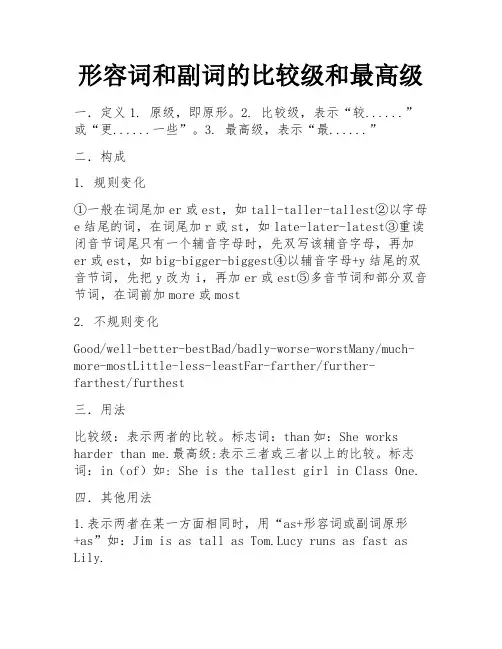
形容词和副词的比较级和最高级一.定义1. 原级,即原形。
2. 比较级,表示“较......”或“更......一些”。
3. 最高级,表示“最......”二.构成1. 规则变化①一般在词尾加er或est,如tall-taller-tallest②以字母e结尾的词,在词尾加r或st,如late-later-latest③重读闭音节词尾只有一个辅音字母时,先双写该辅音字母,再加er或est,如big-bigger-biggest④以辅音字母+y结尾的双音节词,先把y改为i,再加er或est⑤多音节词和部分双音节词,在词前加more或most2. 不规则变化Good/well-better-bestBad/badly-worse-worstMany/much-more-mostLittle-less-leastFar-farther/further-farthest/furthest三.用法比较级:表示两者的比较。
标志词:than如:She works harder than me.最高级:表示三者或三者以上的比较。
标志词:in(of)如: She is the tallest girl in Class One.四.其他用法1.表示两者在某一方面相同时,用“as+形容词或副词原形+as”如:Jim is as tall as Tom.Lucy runs as fast as Lily.2.表示一方在某方面不如另一方时,用“not as/so+形容词或副词原形+as”如:Jim is not as/so smart as Tom.3.比较级+and+比较级,more and more+原级,译为越来越......如:The weather is getting colder andcolder.She bees more and more beautiful.4.the+比较级,the+比较级。
意思是越......越......如:The harder you are,the luckier you are.5.比较级常见修饰词如:much,a lot, far,a little,evenShe is much taller than me.---完---也许你还想看:“如此”这样用动词短语的用法。


高考英语语法之形容词和副词第一部分考点精讲精练第1讲比较级考点1.可以修饰比较级的词常用来修饰比较级的词或短语有:a bit, a little, rather, much, far, by far, many, a lot, a great deal, any, still, even等。
by far的用法:用于强调,意为“……得多” “最最……” “显然”等,可修饰形容词或副词的比较级和最高级,通常置于其后,但是若比较级或最高级前有冠词,则可置于其前或其后。
如:It’s quicke r by far to go by train. 乘火车要快得多。
She ran fastest by far. 她跑得最快(显然她跑得最快)。
He’s by far the cleverer student.他是个聪明得多的孩子。
He is by far the best teacher.=He is the best teacher by far.他是最最好的老师(或他显然是最好的老师)。
1.You are such a woman as always think ____ ofyourself than others.A. muchB. much moreC. littleD. much less2.【2004福建】The number of people present at theconcert was _____than expected. There were many ticket left.A. much smallerB. much moreC. much largerD. many more3.-The novel is, I have to say, not a bit interesting,How do you find it?-Why! It’s ____________ that I have ever read.A. a most interestingB. a more interestedC. a less interestingD. by far the most interesting4.【2007 全国II】After two years’ research, we no whave a ____ better understanding of the disease.A. veryB. farC. fairlyD. quite 5.------ The disease he suffers is not easy to cure.------ I know, but is he _____ better?A. muchB. ratherC. anyD. little6.【2000上海】You're standing too near the camera.Can you move ______ ?A. a bit farB. a little fartherC. a bit of fartherD. a little far7.【2006江苏】I wish you’d do ________ talking andsome more work. Thus things will become better.A. a bit lessB. any lessC. much moreD. a little more考点2.more 、much与比较级more 和多音节形容词和副词一起构成比较级,如more interesting, more exciting单音节词和部分双音节词在后面加-er构成比较级. 如:taller, earlier, hottermuch修饰比较级。
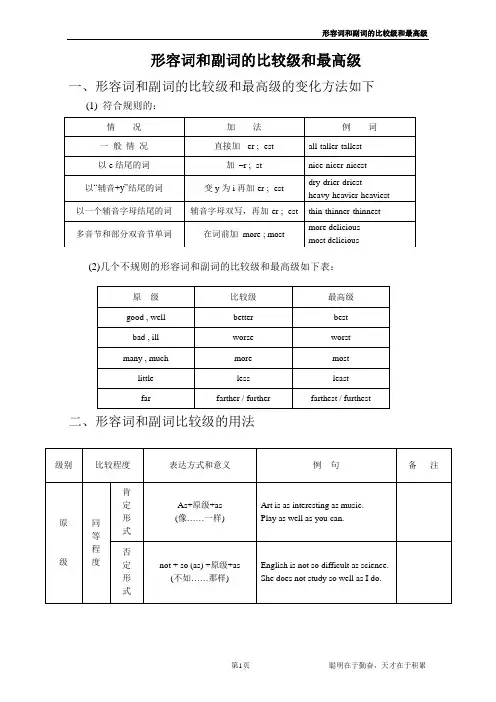
形容词和副词的比较级和最高级一、形容词和副词的比较级和最高级的变化方法如下(1) 符合规则的:(2)几个不规则的形容词和副词的比较级和最高级如下表:二、形容词和副词比较级的用法注意:有些形容词,如 dead, empty, round, sure, woolen 等受本身含义的限制,没有比较级。
例题解析1. He is ________ friends than I.A. much moreB. many moreC. very moreD. too more解析:后面有可数名词复数时,many的比较级形式为many more 修饰。
应选B.2. Which is the _________ country, Japan or Australia?A. more developedB. more developingC. most developedD. most developing解析:两者比较用比较级,表示"发达"用developed, 而developing 是"发展中的" 意思3. There were _______ shops in the city in 1982 than in 1990.A. littleB. fewC. fewerD. less解析:little 不能修饰可数名词,两者比较需用比较级,所以应选C.4. If you are not free today, come another day __________.A. tooB. soC. insteadD. yet解析:instead 作副词用时意为"代替,顶替",表示前面的事情没做,而是做了后面的事。
Instead一般位于句首。
应选C.5.He can't tell us ________, I think.A. important anythingB. anything importantC. important somethingD. something important.解析:不定代词与形容词联用需后置,否定句中应该用anything而不是something. 因此应选B6. The Huang River is the second __________ river in our country.A. longB. longerC. longestD. the longest解析:"定冠词the+ 序数词+ 形容词最高级" 表示"第几大……" 应选C.7. The light in the office wasn't ________for him to read.A. enough brightB. bright enoughC. brightlyD. enough brightly解析:enough修饰名词时可前可后,修饰形容词或副词时,要后置。
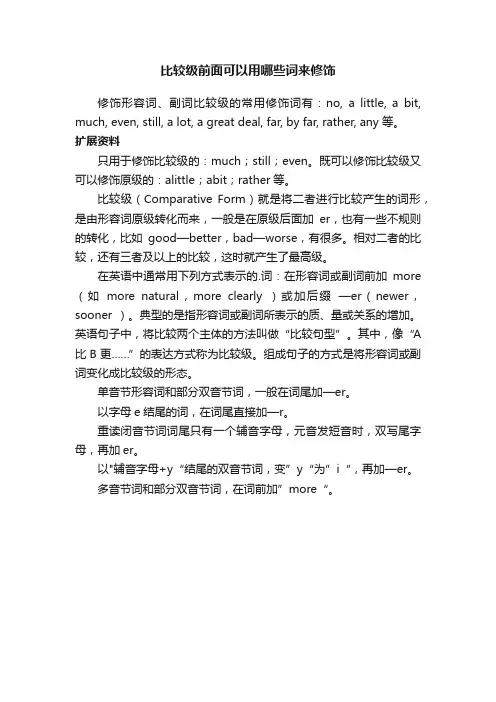
比较级前面可以用哪些词来修饰
修饰形容词、副词比较级的常用修饰词有:no, a little, a bit, much, even, still, a lot, a great deal, far, by far, rather, any 等。
扩展资料
只用于修饰比较级的:much;still;even。
既可以修饰比较级又可以修饰原级的:alittle;abit;rather等。
比较级(Comparative Form)就是将二者进行比较产生的词形,是由形容词原级转化而来,一般是在原级后面加er,也有一些不规则的转化,比如good—better,bad—worse,有很多。
相对二者的比较,还有三者及以上的比较,这时就产生了最高级。
在英语中通常用下列方式表示的.词:在形容词或副词前加more (如more natural,more clearly )或加后缀—er(newer,sooner )。
典型的是指形容词或副词所表示的质、量或关系的增加。
英语句子中,将比较两个主体的方法叫做“比较句型”。
其中,像“A 比B更……”的表达方式称为比较级。
组成句子的方式是将形容词或副词变化成比较级的形态。
单音节形容词和部分双音节词,一般在词尾加—er。
以字母e结尾的词,在词尾直接加—r。
重读闭音节词词尾只有一个辅音字母,元音发短音时,双写尾字母,再加er。
以"辅音字母+y“结尾的双音节词,变”y“为”i“,再加—er。
多音节词和部分双音节词,在词前加”more“。
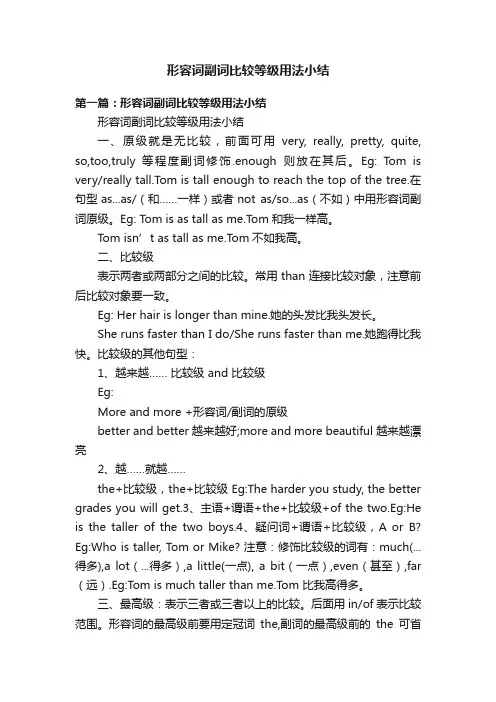
形容词副词比较等级用法小结第一篇:形容词副词比较等级用法小结形容词副词比较等级用法小结一、原级就是无比较,前面可用very, really, pretty, quite, so,too,truly 等程度副词修饰.enough则放在其后。
Eg: Tom is very/really tall.Tom is tall enough to reach the top of the tree.在句型as...as/(和……一样)或者not as/so...as(不如)中用形容词副词原级。
Eg: Tom is as tall as me.Tom和我一样高。
Tom isn’t as tall as me.Tom不如我高。
二、比较级表示两者或两部分之间的比较。
常用than连接比较对象,注意前后比较对象要一致。
Eg: Her hair is longer than mine.她的头发比我头发长。
She runs faster than I do/She runs faster than me.她跑得比我快。
比较级的其他句型:1、越来越…… 比较级 and 比较级Eg:More and more +形容词/副词的原级better and better 越来越好;more and more beautiful 越来越漂亮2、越……就越……the+比较级,the+比较级 Eg:The harder you study, the better grades you will get.3、主语+谓语+the+比较级+of the two.Eg:He is the taller of the two boys.4、疑问词+谓语+比较级,A or B? Eg:Who is taller, T om or Mike? 注意:修饰比较级的词有:much(...得多),a lot(...得多),a little(一点), a bit(一点),even(甚至),far (远).Eg:Tom is much taller than me.Tom 比我高得多。
能够修饰形容词、副词的比较级和最高级的词或短语■崔长平河南遂平一高(463100)1)经常用来修饰形容词或副词的比较级形式,以示加强语气。
常见的词或短语有:much (very much,too much ),even,still,far,rather,any, no,not,by far, a lot,a little,a bit,a great deal 等。
e.g.He is getting (too) much fatter these days(加强语气时,可以使用too much 或 very much。
)It was cold yesterday, but it’s even colder today.There was a number of people out this afternoon, far more than last Sunday.His work is better by far than that of any other printer in the city.She was by far the better actress in the West.(by far经常置于比较级之后,若比较级加有定冠词时,常置于定冠词之前。
)Tom is tall but Mary is still taller / taller still.(still可以置于比较级之前或之后。
)He was too tired to walk any further.(any经常用于条件句、否定句、疑问句或具有疑问、否定语气的句子中。
)It’s no faster to go there by train than by car.乘火车去那里和乘汽车去那里一样不快。
(no 修饰比较级时,对参与比较的双方同时予以否定,比较的双方“都不……”。
)It’s not faster to go there by train than by car.乘火车去那里不及坐汽车去那里来得更快些。
一、形容词和副词的概念形容词:是修饰名词(人或事物),表示名词的性质,特征或属性一种词类.它在句中作定语、表语和宾语补足语。
副词:用来修饰动词、形容词及其他副词的词叫副词.副词在句中多作状语。
二、形容词和副词的用法①形容词作定语一般放在被修饰的名词之前。
如: a new book, two big trees等.②形容词放在系动词be , get, turn, become, keep, stay, look, smell, feel, taste,sound, 等之后.如:1。
I am short。
2。
She looks fine.3.They turn green.③如果形容词修饰不定代词something,anything, everything, nothing等时,要放在不定代词后面。
如:something interesting nothing new④副词放在所修饰的动词之后、形容词和副词之前.如果前面是行为动词,则后面用副词。
如: 1.She works hard .(修饰动词)2.I am very busy.(修饰形容词)3。
He runs too quickly .(修饰副词)4。
We play happily。
(修饰动词)⑤通常在形容词后加-ly变成副词。
形容词副词比较级最高级变化形式归纳大多数形容词和副词有比较级和最高级的变化,即原级、比较级和最高级,用来表示事物的等级差别。
原级即形容词的原形,比较级和最高级有规则变化和不规则变化两种。
规则变化1.单音节以及少数双音节的词后面直接加-er 或—est原级比较级最高级tall taller tallestsmart smarter smartestshort shorter shortest特别提醒:以-y,-er, -ow, le结尾的双音节形容词末尾加er和est.如:healthy, funny, busy, hungry, easy, happy, early, pretty, lazy, heavy,dirty, clever, narrow等。
形容词和副词比较级和最高级的构成、用法及标志词我们知道形容词和副词有三个等级:1.原级,即原形。
2.比较级,表示“较……”或“更……一些”,两个事物进行比较。
3.最高级,表示“最……”,三个或三个以上的事物进行比较。
现在我们来看看它们的构成吧!第一,规则变化1. 现在词尾加-er/est.eg:tall-taller-tallestwarm-warmer-warmestquiet-quieter-quietest2. 以字母e结尾的词,在词尾加-r/-st.eg: late-later-latestfine-finer-finestlarge-larger-largestclose-closer-closest3. 以辅音字母加-y结尾的双音节词,先把“y”改为“i”,再加-er/-est.eg: easy-easier-easiestearly-earlier-earliestfunny-funnier-funniestfriendly-friendlier-friendliestbusy-busier-busiest4. 以只有一个辅音字母结尾的重读闭音节词,先双写辅音字母再加-er/-est.eg: big-bigger-biggesthot-hotter-hottestwet-wetter-wettestfat-fatter-fattestthin-thinner-thinnest5. 多音节词,在词尾加-more/-most.eg: beautiful-more beautiful-most beautifulserious-more serious-most seriousoutgoing-more outgoing-most outgoing第二,不规则变化不规则变化就只有这几个词,大家只需牢牢记在心里就好了。
good/well-better-bestbad/badly/ill-worse-worstmany/much-more-mostlittle-less-leastfar-farther/further-farthest/furthest以上是给同学总结的形容词即副词的比较级和最高级的构成,所举的例子也是常用到的单词,希望大家最好把这些单词背下来。
完整)形容词、副词比较级、最高级n A:形容词和副词的比较级一、形容词和副词比较级的基本用法比较级是用来表示事物之间的比较的,通常用于表示“较……”或“更……一些”,比较级的标志词是“than”。
例如:猫比其他动物更可爱。
形容词或副词比较级前可以加修饰语,如much、a lot、a bit、a little、slightly、a great deal等。
例如:今天她感觉好多了。
比较级也可以与any、no、even、some、still等词一起使用,表示更多或更少的程度。
例如:你今天感觉好些了吗?她和XXX一样年轻。
比较级也可以与数词一起使用,表示年龄、大小等方面的比较。
例如:我妹妹比我小十岁。
二、比较级的特殊搭配1.“比较级+and+比较级”表示“越来越……”。
例如:他越来越胖了。
2.“The +比较级…,the +比较级”表示“越……,越……”。
例如:他越忙就越高兴。
越多越好。
3.“the+比较级(+of the two)”表示“两者中较……的那个人或物”。
例如:他是两个人中较高的那个。
4.“the more… the more…”表示“越……越……”。
例如:你越努力工作,就越能获得更大的成功。
5.“more than”表示“不仅仅是”,“less than”表示“不到”,“no less than”表示“不少于”。
例如:这不仅仅是一部电影,它还是一部文化现象。
6.“as+形容词/副词原级+as…”表示“与…一样”,否定词语+“so…as”表示最高级含义。
例如:没有比这更简单的了。
这个故事和那个一样有趣。
7.表示倍数的词或其他程度副词做修饰语,放在as的前面。
例如:她的阅读速度是你的两倍。
1.His handwriting is better than any other student in the class。
2.Gold is less useful than iron。
3.My sister is two years older than I am。
形容词和副词的比较级和最高级的构成形容词和副词是英语语法中常见的词性,用于描述或修饰名词和动词。
在表达程度、大小和范围时,我们通常会使用比较级和最高级。
本文将介绍形容词和副词构成比较级和最高级的规则和例子,帮助读者更好地理解和运用。
一、形容词和副词的比较级构成比较级用于表示两个事物之间的比较,可以用来描述相对程度的大小。
一般情况下,形容词和副词的比较级构成如下:1. 一般在形容词和副词后面加上-er,例如:- Tall(高)的比较级是Taller(更高的)- Fast(快)的比较级是Faster(更快的)2. 以辅音字母+y结尾的形容词,变y为i,再加上-er,例如:- Happy(高兴)的比较级是Happier(更高兴的)- Easy(容易)的比较级是Easier(更容易的)3. 以重读闭音节结尾,且末尾只有一个辅音字母的形容词,则要双写这个辅音字母,再加上-er,例如:- Big(大)的比较级是Bigger(更大的)- Hot(热)的比较级是Hotter(更热的)4. 部分形容词的比较级构成是不规则的,需要记忆,例如:- Good(好)的比较级是Better(更好的)- Bad(坏)的比较级是Worse(更糟糕的)- Little(小)的比较级是Less(更少的)二、形容词和副词的最高级构成最高级用于表示三个或三个以上事物之间的比较,表示程度最高的一方。
形容词和副词的最高级构成如下:1. 在形容词和副词前面加上the most,例如:- Beautiful(美丽)的最高级是The most beautiful(最美丽的)- Quickly(快速地)的最高级是The most quickly(最快速的)2. 部分形容词的最高级构成是不规则的,需要记忆,例如:- Good(好)的最高级是The best(最好的)- Bad(坏)的最高级是The worst(最糟糕的)- Little(小)的最高级是The least(最少的)三、形容词和副词比较级和最高级的使用形容词和副词的比较级和最高级可以用来对事物进行比较和排序。
比较级和最高级前的修饰语在英语中,形容词和副词的比较级和最高级常用某些词或词组加以修饰,来加强语气。
现就常见的一些修饰语作一简述。
一、比较级的修饰语主要用于两种结构:1.用于修饰as(so)…as…比较句型的修饰语。
常见的有almost,exactly,nearly,just,quite,倍数、分数、百分数等,这些词都置于第一个as之前。
eg:The rock is almost/nearly as heavy as that one.这块岩石与那块一样重。
Making the water dirty is just as dangerous as polluting the air.水受污染和空气受污染同样有危害。
We have produced three times as much rice this year as last year.我们今年生产的大米是去年的3倍。
The speed of the heavy trucks is two-thirds as fast as the light ones.重型卡车的速度是轻型卡车的三分之二。
2.修饰more than比较结构的修饰语较多。
(1)a(little)bit,a little,slightly somewhat,any等常放在比较级前,表示两者差别不大,常译为“一些”、“一点”、“稍微”,其中any一般用于疑问句,其他则多用于肯定句。
These tomatoes are a little cheaper than those.这些西红柿比那些稍便宜点。
Our garden is slightly bigger than yours.我们的花园比你们的稍大点。
Are you feeling any better today?你今天好点了吗?(2)(very)much,(by)far,many,greatly,rather,a lot,lots,a great(good)deal 等除by far外常放在比较级前表示差别较大,常译为“……得多”,by far常用在比较级后;而many只能修饰形容词比较级,且这个形容词必须修饰着可数名词复数。
能够修饰形容词、副词的比较级和最高级的词或短语
■崔长平河南遂平一高(463100)
1)经常用来修饰形容词或副词的比较级形式,以示加强语气。
常见的词或短语有:much (very much,too much ),even,still,far,rather,any, no,not,by far, a lot,a little,a bit,a great deal 等。
e.g.
He is getting (too) much fatter these days
(加强语气时,可以使用too much 或 very much。
)
It was cold yesterday, but it’s even colder today.
There was a number of people out this afternoon, far more than last Sunday.
His work is better by far than that of any other printer in the city.
She was by far the better actress in the West.
(by far经常置于比较级之后,若比较级加有定冠词时,常置于定冠词之前。
)
Tom is tall but Mary is still taller / taller still.
(still可以置于比较级之前或之后。
)
He was too tired to walk any further.
(any经常用于条件句、否定句、疑问句或具有疑问、否定语气的句子中。
)
It’s no faster to go there by train than by car.
乘火车去那里和乘汽车去那里一样不快。
(no 修饰比较级时,对参与比较的双方同时予以否定,比较的双方“都不……”。
)
It’s not faster to go there by train than by car.
乘火车去那里不及坐汽车去那里来得更快些。
(not 修饰比较级时,对参与比较的双方同时予以肯定,但强调“前者不及后者更……。
)
Are you felling a lot better today?
He was a little more worried than the others.
2)经常用来修饰形容词或副词的最高级,用来加强语气。
常见的词或短语如:
much the … the very … the …by far by far the …等。
This is much the / by far the most difficult of the five questions.
(much经常置于定冠词之前。
)
The last novel of his is by far the best he has written.
The Pacific is the largest ocean in the world by far.
(by far可以置于定冠词之前,也可以置于最高级之后。
)
This cake ought to be good, because I used the very best butter.
1。